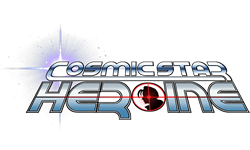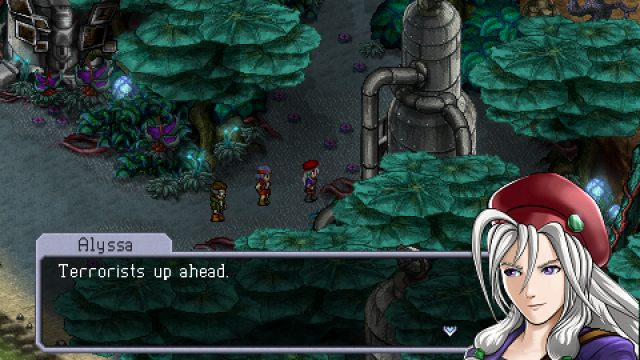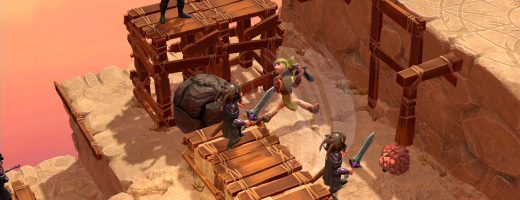Cosmic Star Heroine Switch Review
Only Half a Space Cadet
It’s not news that fans pining for an enjoyable romp filled with the RPG trappings of the 8- and 16-bit eras need look no further than whatever latest offering Zeboyd Games has cooked up. After making a name for themselves with earlier efforts like Cthulhu Saves the World and Breath of Death VII, the two-man development team next looked to the nineties for inspiration. Cosmic Star Heroine is the end result of a successful 2013 Kickstarter campaign, and features an aesthetic, particularly with its combat system, reminiscent of classics like Chrono Trigger. But CSH doesn’t quite reach the same lofty heights as its inspirations, with a simple story and a few too many bells and whistles added to its combat system, making encounters become just a tad too cumbersome towards the end of the game’s fifteen-or-so-hour campaign.
Alyssa L’Salle is one of the top agents in the API, the Agency for Peace and Intelligence, and as such one of the galaxy’s premier covert operatives. Taking on the role of an established secret agent in an RPG is a novel idea, and being thrown into the game’s introductory mission where Alyssa must infiltrate a building to defuse a hostage crisis immediately generates interest in the game’s narrative. Alyssa already has a number of interesting abilities, as well as her trusty bo staff, at her disposal to deal with imminent threats, as well as the support of fellow agents Dave and Chahn, who provide backup via radio and in person, respectively.
Things are off to a roaring start right away, and the game’s combat system at first seems to further sweeten the deal. Characters have access to a selection of up to eight different moves during battle, previously selected to be part of their combat loadout. The majority of abilities, when used, add to a character’s Style Points, which grant additional damage and protection the longer a battle rages on. Hyper Points, on the other hand, increase by one each turn, and when the gauge fills every couple of turns before resetting itself, the move performed that turn will be extra powerful, whether offensively or defensively. The party also has access to a shared inventory of single-use-per-encounter items — which, again, must be equipped in advance from a total pool of inventory items — and each character’s armor grants further once-per-battle abilities, with more becoming available as characters level up and equip different sets of armor. That’s an awful lot of individual systems that help keep the combat feeling interesting and unique, at least in the game’s early hours.
While the battle system provides for a lot of versatility early on, it does begin to show some cracks during later chapters. Eight combat abilities per character may sound like a good amount, but as more moves are gained, it becomes a bit of a chore to not only decide what to leave out in favor of a brand-new ability, but also how to keep the battle party of four constantly balanced and prepared for various situations. With little reliance on restorative items, a dedicated healer must be put in place, and suitably equipped for the job. The majority of combat abilities deactivate after use, and require an entire turn spent on using a recharging ability to become available again, thus effectively subtracting one of each character’s eight ability slots.
Cosmic Star Heroine places a lot of emphasis on exploiting enemies’ elemental weaknesses, which, by and large, is a welcome tactical consideration in combat. As a result, there are very few moves that are just plain physical attacks; almost every ability has an elemental affinity or status effect to take into consideration. When coupled with Style and Hyper Points, there are a great many plates spinning during even the most casual of enemy encounters that must be kept track of. This, however, is precisely what makes late-game dungeons so tedious. Enemies, naturally, come with larger and larger health pools as the game progresses, calling for extensive combat scenarios to slowly whittle away at their HP. Often, once a suitable party has been assembled, it takes each encounter’s first few turns just to set up the battlefield, casting defensive shields, damage-over-time poisons, and retaliatory buffs. In effect, dotting every I and crossing every T feels like a quasi ability-management mini-game — one that begins anew with each and every enemy encounter, and ends up feeling too much like a chore.
The story also loses some of its interest after those initial hours of secret agent intrigue. The novelty of having a protagonist that’s part of a secret organization operating out of the shadows is replaced with “Outnumbered Hero must stop Big Bad from doing Terrible Things to the galaxy.” What’s somewhat more interesting are the individual story beats, the personal vignettes as the remainder of the relatively large cast is introduced one by one. Standouts include meeting the leader of an underground resistance movement and becoming embroiled in the murder of a prominent civil official, complete with trenchcoat-wearing gumshoe.
Unfortunately, not all members of the eleven-man cast enjoy the same level of interesting development — by sheer virtue of cramming so many characters into such a relatively short game — and several candidates become relegated to the back burner the very moment they are assigned a permanent place on the squad. Sadly, the game’s brevity means sacrifices were made in character development, and several cast members cease to show any further involvement in the plot after their introduction. Regardless of the questionable success of fleshing each character out as fully as the developers no doubt wanted, the effort to create a cast full of colorful personalities is more than evident. Thankfully, Zeboyd Games does a great job capitalizing on CSR‘s science fiction setting, allowing players to travel to one imaginative locale after the next, which injects the game with some much-needed character to make up for the writing’s occasional shortcoming.
Cosmic Star Heroine‘s art style further emulates the look of 16-bit console days, though of course the game isn’t shy about occasionally sneaking in some cleaner and more advanced graphical tricks. For example, some key moments are presented via animated cinematics, done in a very retro pixellated style that looks more like something found in handheld rereleases of old-school RPGs. On-screen character portraits used for dialog are large and very nicely detailed, allowing for a good amount of emoting and even changing to match a character’s look in the story at certain times. The Switch allows for gorgeously sharp pixel art in handheld mode, as well as enjoying it in all its glory on a large screen when docked; Cosmic Star Heroine looks amazing either way. The only thing that could have put the game over the top in this department might have been a few more inventive flourishes during combat animations, lending some more visual flair during battles.
In the music department, Cosmic Star Heroine manages to competently hold its own, neither wowing nor specifically disappointing in any way. Themes are there, but don’t seem to be able to get themselves permanently stuck in the player’s memory. Voiceovers don’t exist, though this is only noticeable if viewed through the lens of modern trappings; neither the style the game is aping, nor Zeboyd’s past development history, set any expectation of a voiceover cast appearance. The Switch version, being the most-recently released, has had the benefit of a few more months in the oven, letting the devs iron out some of the previous iterations’ bugs. In one full playthrough, Cosmic Star Heroine only locked up once during a late-game battle scene, necessitating a software restart and losing about an hour’s worth of progress.
Cosmic Star Heroine is far more than a simple send-up of some of the genre’s most beloved classics. It may imitate a similar art style and plot development, but it shows a good amount of innovation in some key areas. Particularly its combat system is packed with new and interesting ideas that require a good deal of attention paid during even rote battles. The variety of combat systems end up being as much of a drawback as an advantage late in the game, though, when lengthy skirmishes seem needlessly protracted. What still remains is a fun, if not terribly demanding galactic romp to save the cosmos alongside a crew of colorful, if not terribly deep pals.


Consciously highlights all the things that were great about pixel art graphics
Setting and character designs take full advantage of sci-fi palette
A combat system with some interesting ideas in play...
...that don't translate well to some of the game's lengthier battles
Main narrative quickly devolves into "been there, done that"
Some cast members entirely devoid of characterization or use








Recent Comments